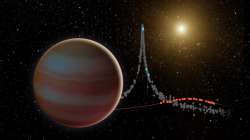NASA space telescopes 'Spitzer' and 'Swift' discover elusive brown dwarf
A unique collaboration between NASA's Spitzer and Swift space telescopes have led to a discovery of a new brown dwarf - thought to be the missing link between planets and stars, with masses up

A unique collaboration between NASA's Spitzer and Swift space telescopes have led to a discovery of a new brown dwarf - thought to be the missing link between planets and stars, with masses up to 80 times that of Jupiter.
Researchers observed a microlensing event, when a distant star brightens due to the gravitational field of at least one foreground cosmic object.
This technique is useful for finding low-mass bodies orbiting stars, such as planets. In this case, the observations revealed a brown dwarf.
Brown dwarfs are thought to be the missing link between planets and stars, with masses up to 80 times that of Jupiter.
But their centres are not hot or dense enough to generate energy through nuclear fusion the way stars do. Scientists have found that, for stars roughly the mass of our sun, less than 1 per cent have a brown dwarf orbiting within 3 AU (1 AU is the distance between Earth and the sun).
This phenomenon is called the "brown dwarf desert."
The newly discovered brown dwarf, which orbits a host star, may inhabit this desert. Spitzer and Swift observed the microlensing event after being tipped off by ground-based microlensing surveys, including the Optical Gravitational Lensing Experiment (OGLE).
The discovery of this brown dwarf, with the unwieldy name OGLE-2015-BLG-1319, marks the first time two space telescopes have collaborated to observe a microlensing event.
"We want to understand how brown dwarfs form around stars, and why there is a gap in where they are found relative to their host stars," said Yossi Shvartzvald, a NASA postdoctoral fellow based at Jet Propulsion Laboratory in California.
"It's possible that the 'desert' is not as dry as we think," said Shvartzvald.
In a microlensing event, a background source star serves as a flashlight for the observer.
When a massive object passes in front of the background star along the line of sight, the background star brightens because the foreground object deflects and focuses the light from the background source star.
Depending on the mass and alignment of the intervening object, the background star can briefly appear thousands of times brighter.
Spitzer observed the binary system containing the brown dwarf in July last year.
By combining data from these space-based and ground-based telescopes, researchers determined that the newly discovered brown dwarf is between 30 and 65 Jupiter masses.
They also found that the brown dwarf orbits a K dwarf, a type of star that has about half the mass of the sun.
The finding was published in the Astrophysical Journal.
(With agency inputs)